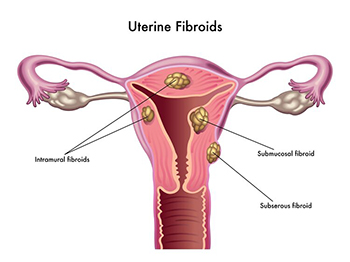In this article, Epworth Richmond gynaecologist A/Prof Alex Ades, an experienced specialist Gynaecologist and minimally invasive surgeon in Melbourne, explains what Fibroids are, how they are diagnosed and what treatments are available.
 Uterine fibroids, also known as fibromas, myomas or leiomyomas, are benign uterine tumours that grow from the muscular cells of the uterine walls. Think of them as lumps of tissue usually round or oval that grow in the womb. Fibroids are different from endometriosis which are growths of uterine cells from the lining of the uterine cavity, the endometrium.
Uterine fibroids, also known as fibromas, myomas or leiomyomas, are benign uterine tumours that grow from the muscular cells of the uterine walls. Think of them as lumps of tissue usually round or oval that grow in the womb. Fibroids are different from endometriosis which are growths of uterine cells from the lining of the uterine cavity, the endometrium.
Fibroids are the most common tumours of the female genital tract, affecting a very large number of women. The most common age group is between 30 and 50 years old. They vary greatly in size, number and position within the uterus. Women with fibroids may therefore experience very different symptoms. Some do not experience any changes and wouldn’t know they have a fibroid unless they have an ultrasound, others can experience very significant bleeding and/or feel a mass in the pelvis that resembles being pregnant and puts pressure on the bladder and/or bowels.
Fibroids are benign growths and there is usually no concern about them spreading like cancer. The biggest burden on women is caused by bleeding which can be quite heavy and debilitating and the fact that some fibroids may distort the uterus to the point of making it difficult to carry a pregnancy.
The diagnosis of fibroids can be made either by physical examination where the doctor can feel an enlarged uterus or by imaging, the most common being ultrasound.
The treatment will be different for each person and depends on a number of factors that include: severity of symptoms; size, number and position of fibroids; the woman’s age; desire for fertility.
There are three main groups of treatment:
- Conservative management where no treatment is required, and the fibroids are monitored with ultrasound every 6 to 12 months.
- Treatment for bleeding where the fibroids do not have to be removed and the bleeding can be controlled with medication such as tranexamic acid, progesterone tablets or a progesterone intra-uterine device. These group also include Uterine Artery Embolisation (UAE) and MRI guided focused ultrasound (MRgFus), interventionist radiology modalities that try to reduce the size of the fibroids.
- Surgical removal of fibroids. The main operations available are a myomectomy where the fibroids are removed and the uterus preserved or a hysterectomy where the uterus is removed with all the fibroids. Most of these the surgical interventions are done using minimally invasive techniques such as hysteroscopy, laparoscopy and robotic surgery. In either case, there is no need to remove the ovaries.
Author Info
Assoc. Prof. Alex Ades is an Epworth Richmond specialist Obstetrician and Gynaecologist accredited by the Royal Australian and New Zealand College of Obstetricians and Gynaecologist (RANZCOG), the Health Insurance Commission and the Medical Board of Australia.
Assoc. Prof. Alex Ades is an extensively trained and experienced minimally invasive laparoscopic and robotic surgeon and has been involved in public and private practice as well as academic tertiary education for more than 20 years.
03 March 2020


